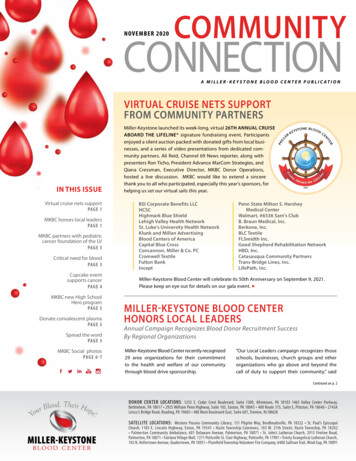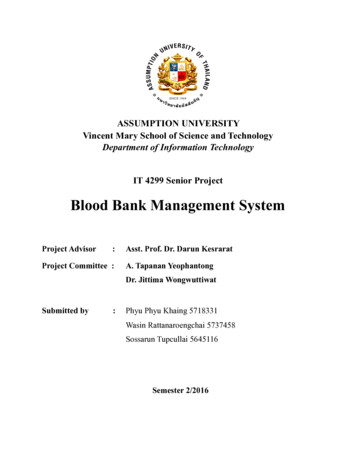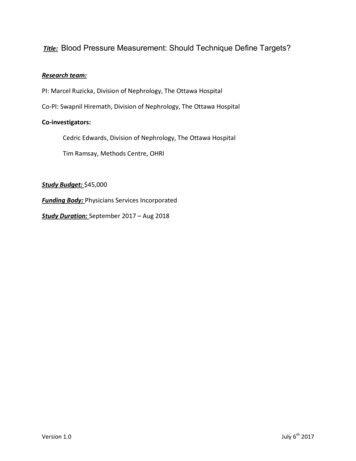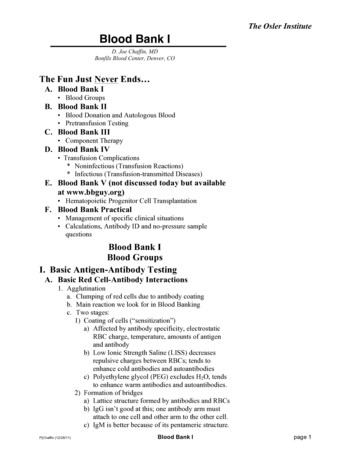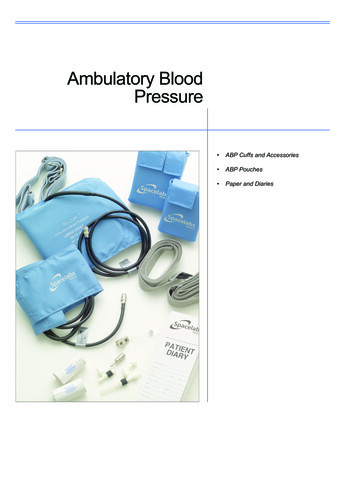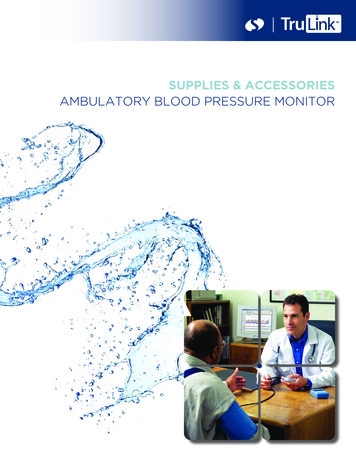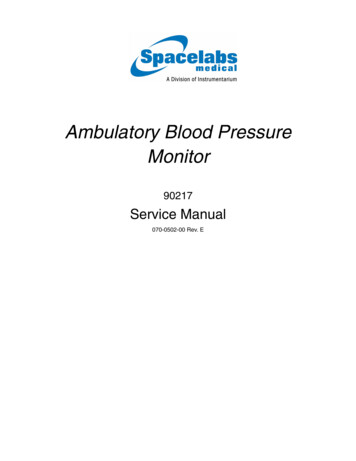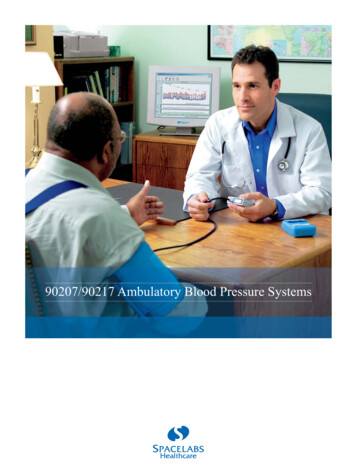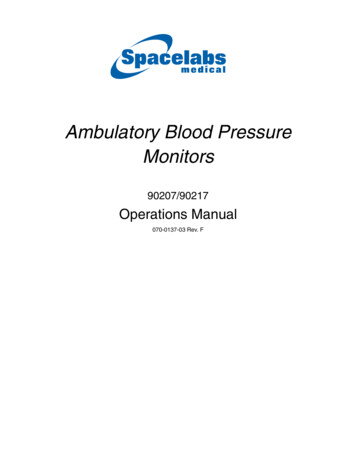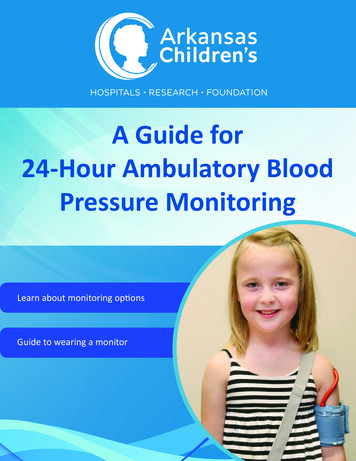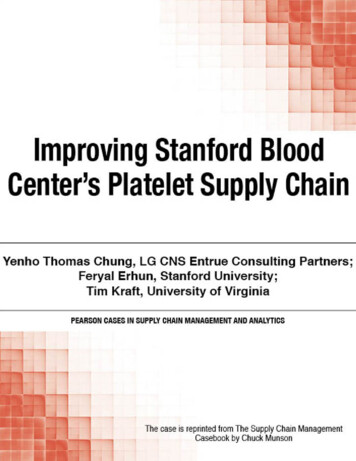
Transcription
Improving StanfordBlood Center’s PlateletSupply ChainChuck Munsonwith Yenho Thomas Chung, Feryal Erhun,and Tim Kraft
Vice President, Publisher: Tim MooreAssociate Publisher and Director of Marketing: Amy NeidlingerExecutive Editor: Jeanne Glasser LevineOperations Specialist: Jodi KemperManaging Editor: Kristy HartSenior Project Editor: Betsy GratnerCompositor: Nonie RatcliffManufacturing Buyer: Dan Uhrig 2014 by Chuck MunsonPublished by Pearson Education, Inc.Publishing as FT PressUpper Saddle River, New Jersey 07458FT Press offers excellent discounts on this book when ordered in quantity for bulk purchasesor special sales. For more information, please contact U.S. Corporate and Government Sales,1-800-382-3419, corpsales@pearsontechgroup.com. For sales outside the U.S., please contactInternational Sales at international@pearsoned.com.Company and product names mentioned herein are the trademarks or registered trademarksof their respective owners.All rights reserved. No part of this book may be reproduced, in any form or by any means,without permission in writing from the publisher.ISBN-10: 0-13-375738-2ISBN-13: 978-0-13-375738-5Pearson Education LTD.Pearson Education Australia PTY, Limited.Pearson Education Singapore, Pte. Ltd.Pearson Education Asia, Ltd.Pearson Education Canada, Ltd.Pearson Educación de Mexico, S.A. de C.V.Pearson Education—JapanPearson Education Malaysia, Pte. Ltd.Reprinted from The Supply Chain Management Casebook (ISBN: 9780133367232) byChuck Munson.
Improving Stanford Blood Center’sPlatelet Supply Chain1Yenho Thomas Chung†, Feryal Erhun‡, and Tim Kraft*William leaned back in his chair and looked at the platelet outdatenumbers for April again. One-third of the platelets outdated—howcould this be? William’s boss and the platelet donors would not bepleased. As the project manager for Stanford Blood Center’s (SBC)process improvement initiative, William knew that he and his teamhad to do something fast; otherwise, SBC would start to lose valuable donors and incur platelet shortages. Due to the short shelf-lifefor platelets (five days) and volatile demands, it was critical that SBCcarefully manage the platelet supply process, which included distributing platelets to local hospitals as well as collecting and redistributingunused platelet inventory among those hospitals. However, as April’snumbers demonstrated, there were significant flaws in SBC’s plateletsupply process.Because his team was mainly composed of medical personneland staff, William decided to seek outside support for SBC’s platelet1This case was prepared by Yenho Thomas Chung (LG CNS Entrue Consulting Partners), Professor Feryal Erhun (Stanford University), and Professor TimKraft (University of Virginia) based on field research of an actual business situation. Some names, dates, and data are disguised, and some material is fictionalized for pedagogical reasons. It was written as a basis for class discussion ratherthan to illustrate effective or ineffective handling of an administrative situation.The authors would like to thank their collaborators at Stanford Blood Center andStanford University Medical Center for their efforts.†LG CNS Entrue Consulting Partners, Seoul, South Korea; yhchung@lgcns.com‡Stanford University, Stanford, California, USA; ferhun@stanford.edu*University of Virginia, Charlottesville, Virginia, USA; KraftT@darden.virginia.edu3
4IMPROVING STANFORD BLOOD CENTER’S PLATELET SUPPLY CHAINprocess problem. A few months earlier, he had read an article in theStanford Report on risk management in supply chains by ProfessorFeryal Erhun from Stanford University’s Department of Management Science & Engineering (MS&E). William recognized many ofthe symptoms that Prof. Erhun discussed in her article in the SBCsupply process. Now he just hoped this afternoon’s meeting withProf. Erhun and one of her Ph.D. students would provide insightsinto SBC’s supply problem.Stanford Blood Center: “Give Blood forLife”2Located in Palo Alto, CA, Stanford Blood Center (SBC) is a notfor-profit organization, which was established in 1978 to meet theincreasing needs of Stanford University Medical Center (SUMC),which comprised Stanford University Hospital and Lucile SalterPackard Children’s Hospital. Since then SBC has expanded its scopeto serve El Camino Hospital, the Palo Alto VA, and O’Connor Hospital. In addition to providing blood testing and transfusion services,SBC also acts as a teaching and research setting for Stanford medicalstudents and faculty. It is the second-largest transfusion facility in theU.S with approximately 60,000 blood donations and 100,000 bloodproducts for medical use per year.2SBC has always been on the forefront of transfusion medicine.For example, in 1983, two years before the AIDS virus antibodytest was developed, SBC became the first blood center to screenfor AIDS-contaminated blood. In 1987, SBC became the first bloodcenter in the U.S. to screen donors for HTLV-I, a virus believed tocause a form of adult leukemia. Additionally, SBC was the first bloodcenter in the world to routinely test for cytomegalovirus (CMV) andprovide CMV-negative blood for immuno-compromised transfusionrecipients, and SBC was among the first in the U.S. to provide humanleukocyte antigen (HLA) compatible platelets.2Although most medical institutions are known to be conservativeand reluctant to share their information with outsiders, SBC has always2http://bloodcenter.stanford.edu/
IMPROVING STANFORD BLOOD CENTER’S PLATELET SUPPLY CHAIN5fostered a collaborative environment. This is why William sought outthe help of the MS&E team. However, even with the support of theMS&E team, William knew that the sweeping improvements SBCdesired could not be achieved without the cooperation of SBC’s largest customer, SUMC. William had unsuccessfully approached SUMCstaff previously about working together to improve the supply process.Without solid evidence that there were inefficiencies in the supplychain between SBC and SUMC, it was difficult to convince SUMCstaff that collaboration between SBC and SUMC would improve thesystem efficiency. To get the SUMC staffs’ attention this time, William would need tangible evidence of the inefficiencies in the currentsupply chain.Platelets: Perishable Inventory with Five-Day Shelf LifePlatelets are small cell fragments found in the blood plasma ofmammals. Platelets are responsible for starting the formation of bloodclots when bleeding occurs and thus are often transfused to patientsto treat or prevent bleeding during surgeries. There are no artificialsubstitutes for platelets; platelets transfused to a patient must be collected from another human being. In addition, the donor pool forplatelets is limited due to restrictions on the number of times a donorcan donate per year and the often lengthy donation process.Platelets can either be isolated from whole blood donations orcollected by an apheresis process that requires sophisticated instrumentation and a highly trained support staff. Whole blood donationsare usually collected from random walk-in donors in mobile stationsor local blood collection centers. Whole-blood-derived platelets arethen split from a unit of whole blood that has not been cooled yet.A whole unit of blood contains not only platelets but also red bloodcells, white blood cells, and plasma. Therefore, the amount of wholeblood-derived platelets from a single bag is typically not significant. Incontrast, an apheresis device draws blood from a donor and centrifugesthe collected blood to separate out platelets and other components.Because the remaining blood is returned to the donor during the process, an apheresis donor can provide more platelets than a wholeblood donor can. Typically, an apheresis donor can donate at least
6IMPROVING STANFORD BLOOD CENTER’S PLATELET SUPPLY CHAINone therapeutic dose, whereas generating a therapeutic dose fromwhole-blood-derived platelets requires multiple donations and multiple donors. Because apheresis platelets come from a single donor,they are usually less risky in terms of transfusion-transmitted disease,especially since apheresis platelet donors are registered and closelymonitored by the blood center staff. In addition, because an apheresis dose does not contain as many red blood cells as a whole-bloodderived dose, apheresis platelets do not have to be cross-matched interms of blood types (i.e., ABO and Rh /-).One of the most challenging aspects regarding platelet inventorymanagement is the extremely short shelf-life for platelets. Whereassome European countries allow 7 days of shelf life, in the U.S., Foodand Drug Administration (FDA) regulation requires that everyunused platelet unit be discarded after 5 days. In addition, due to the48-hour testing process that is required right after the donation, thepractical shelf life of platelets is actually only 3 days in the U.S. In partdue to this short shelf life, 10.9% of apheresis platelet units collectedin the U.S. went outdated in 2006; i.e., they expired without beingtransfused. Therefore, to maintain a reasonably high service level anda low outdate rate, the balance between the supply and the demandfor platelets must be closely monitored.SBC’s Platelet Supply ChainSimilar to a typical blood supply chain, SBC’s platelet supply chainstarts with the collection of platelets from donors. Once collected, theplatelets are then processed, tested, and delivered to the hospitalswhere they are either transfused to patients or outdated as shown inFigure 1. There are three critical processes within this supply chain:the collection process, the rotation process, and the issuing process.
IMPROVING STANFORD BLOOD CENTER’S PLATELET SUPPLY itals7PatientsTransfusedAfter2 daysScreeningTestReady-toShipSUMCOutdated(5th day)Figure 1 SBC’s platelet supply chain.The Collection Process: Platelet Collection and TestingOn March 1, 2004, the AABB3 mandated that each blood centerand transfusion service should implement methods to limit and detectbacterial contamination in all platelet components. To comply withthis requirement, SBC transitioned to bacterial culture of plateletproducts and the exclusive use of apheresis platelets. Although SBC iswell-equipped and well-staffed, collecting platelets through an apheresis process is a difficult task. While whole-blood-derived collectionaccommodates random walk-in donors, an apheresis process limitsthe effective donor pool to altruistic, consistent, and highly committed donors due to instrument immobility and the lengthy 1½–2½ hourcollection time.SBC’s marketing department recruits volunteers for regularapheresis platelet donation. It is not easy to recruit a new apheresisplatelet donor. The volunteers donate platelets without any compensation; thus, it is very important to maintain a low outdate rate soas not to impair donors’ motivations. For new volunteers, the donor3AABB is “an international, not-for-profit association representing [nearly 8,000individuals and 2,000 institutions] involved in the field of transfusion medicineand cellular therapies” (http://www.aabb.org).
8IMPROVING STANFORD BLOOD CENTER’S PLATELET SUPPLY CHAINcollection staff performs interviews and checks the medical history,vital signs, and physical status of the prospective donor. Once a volunteer is registered and included in a regular donor pool, the marketing department pre-schedules the donor’s visit to the center. Thecollection staff interviews and examines the prospective donor againto assess his or her eligibility on the day of the donation. A plateletapheresis donor may donate up to 24 times per year.The apheresis process and platelet shelf life begins once the needle is inserted into the donor’s vein. The platelet product expires fivedays after the draw date but due to the requisite 48-hour testing process, the usable shelf life is only three days. All tests must comply withthe standards established by the FDA. First, sample tubes collected atthe time of the platelet donation are submitted for infectious diseasetesting (e.g., blood-borne agents such as HIV, hepatitis, and syphilis).Second, a sample of the platelet unit is cultured for bacterial growth(i.e., bacterial detection). The infectious disease testing is usuallycompleted within 24 hours but the bacterial detection test requires48 hours. Finally, platelets suitable for transfusion are shipped to thehospitals with up to 3 days shelf life remaining. Figure 2 demonstratesthe platelet availability schedule based on draw date.MonTueWedThuFriSatMonDRAW DATETueWedThuFriSatIn TestFigure 2 Platelet availability schedule.AvailableOutdateSun
IMPROVING STANFORD BLOOD CENTER’S PLATELET SUPPLY CHAIN9Currently, SBC schedules donor visits based on the facility capacity, regardless of the incoming demand or the current inventory level.Thus, the number of units collected each day is fairly constant. Inorder to collect the pre-determined daily amount, registered donorsare scheduled several days in advance (Monday through Saturday).Based on historical collection data, the average collection level perday is 40 units Monday through Friday and 60 units on Saturday.Because there is no collection on Sunday and donors are more readilyavailable on Saturdays, SBC collects more platelet units on Saturday.There are several uncertainties in the platelet collection process.For instance, donors may not show up due to personal emergencies,or some donors may not donate due to their own medical status onthe day of the scheduled donation. Thus, to ensure that its needs aremet, SBC schedules more donors than needed to protect againstunexpected loss in supply as well as unexpected spikes in demand.One additional issue with the collection schedule is that some donorscan donate up to three units during a visit due to individual attributessuch as higher platelet counts and body surface. In order to copewith supply uncertainties, SBC often collects the maximum numberof units from each donor. Consequently, on a given day, SBC maycollect a larger amount of platelets than needed; even though thisthen increases the risk that collected units will go outdated. Despitethese precautions, unexpected platelet shortages still occur. Whenthis happens, SBC’s own collection process typically cannot respondquickly enough to demand due to the two-day testing period. In suchsituations, SBC procures additional platelet units from other regionalblood centers.The Rotation Process: Supply Contracts and PlateletRotationsSBC’s largest customer, SUMC, is primarily supplied by SBC.SUMC transfuses approximately 9,100 units of platelets per year,which consumes about 80% of SBC’s platelet supply. To utilize itsremaining apheresis platelet capacity, SBC also serves small local hospitals. SBC works hard to market to these local hospitals. Althoughmost blood centers are not-for-profit organizations, the blood product market is very competitive and generous contracts are oftenused to attract new customers. Due to this competition, SBC offers
10IMPROVING STANFORD BLOOD CENTER’S PLATELET SUPPLY CHAINconsignment contracts to the small local hospitals. Under a consignment contract, SBC delivers fresh platelets based on the hospital’sdaily demand. After two days, the hospitals can then send any leftover or unused units back to SBC. These units, with one day of shelflife remaining, are called “short-dated units.” The small hospitalsare not financially responsible for the short-dated units. They onlypay for the units that they transfuse and any units that expire whilestill in their inventory. Consequently, in order to avoid any financialresponsibility, the small hospitals return almost all unused, two-dayold units. For the small hospitals, this contract is attractive becausethey incur very little risk. Conversely, SBC incurs high risk since itdoes not know how many short-dated units a small hospital mightreturn. When the short-dated units are returned to SBC, these unitsare rotated to SUMC along with fresh units. Short-dated units aresent to SUMC, because it has the highest demand among the hospitals and, therefore, provides the best opportunity for the short-datedunits to be transfused before the end of the day.SUMC orders platelets from SBC two to four times daily. Theages of platelet units delivered to SUMC differ, ranging from three orfour days (fresh units) to five days (short-dated units) old. AlthoughSBC deliveries are triggered by demands at SUMC, not every unitdelivered is added to SUMC’s available inventory. On rare occasions,platelets are discarded due to cancelled transfusions, being out ofrefrigeration too long, or to blood center requests to return questionable products (e.g., donors providing post-donation information thataffects eligibility).4 The major concern for SBC and SUMC, however,is outdated units. As there is little consistency in the age of the platelets SUMC receives, there is a high potential for many of the unitsto become outdated. Due to this high perishable inventory risk, SBCand SUMC have a cost-sharing contract on the outdated units, whichis shown in Table 1.Table 1 SBC and SUMC Cost-Sharing AgreementAge of Platelets When ShippedCost Sharing if Outdated4 days old or youngerSBC (50%)–SUMC (50%)5 days old (short-dated unit)SBC (100%)–SUMC (0%)4Since the number of discarded units is negligible, they are not included in thedata set provided.
IMPROVING STANFORD BLOOD CENTER’S PLATELET SUPPLY CHAIN11According to an AABB survey report, U.S. hospitals paid an average of 538.72 for a unit of apheresis platelets. This cost includes procurement costs, operations costs, testing costs, and processing costs.As shown in Table 1, SUMC incurs 50% of the costs if it receives theproduct before the day of expiration (i.e., fresher units) and does nottransfuse it. Alternatively, SUMC incurs no costs for outdated unitswhen SBC ships short-dated units. SBC staff believe that this costsharing contract reduces the overall system outdate rate, since SUMCreceives short-dated units as well as fresh units because of the pricingstructure of the cost-sharing contract.The Issuing Process: Platelet Demand in SUMCSUMC utilizes platelets for many different types of operations,ranging from day-to-day operations to pre-scheduled or emergencysurgeries; therefore, SUMC always has to stock a certain amount ofplatelet units in its inventory. The platelet supply chain between SBCand SUMC is completely decentralized; i.e., platelet collection androtation decisions are made solely by SBC and platelet ordering andissuing decisions are made solely by SUMC. From SUMC’s previousordering and issuing history, William identified that SUMC orders onaverage 32 platelets per day but transfuses only 25 platelet units onaverage per day.A Snapshot of the SBC-SUMC SupplyChain in 2006For their analysis, William and his team collected data for thenumber of transfusions and outdates during the last four months,from January 2006 to April 2006. Because obtaining this information from the small local hospitals SBC served would be difficult, theteam focused solely on SUMC transactions. The data set includes unitnumber, draw date by SBC, expiration date, received date by SUMC,issue date by SUMC, and if the unit is outdated instead of transfused,the outdate date. Figure 3 demonstrates the outdate rate at SBC andthe number of transfusions at SUMC from January 2006 to April2006. Notice that in April, the outdate rate increased to 30 %, compared to 15% to 20% during the previous months. At the same time,there was a significant decrease in demand in April.
12IMPROVING STANFORD BLOOD CENTER’S PLATELET SUPPLY CHAIN9008007006005004003002001000Outdate Rate30%25%20%15%10%5%0%JanuaryFebruaryOutdate Rate at SBCMarchNumber of Transfusions35%AprilNumber of Transfusions at SUMCFigure 3 SUMC and SBC outdate rate and number of transfusions(Jan.–Apr. 2006).The ProblemAfter hearing William’s over
IMPROVING STANFORD BLOOD CENTER’S PLATELET SUPPLY CHAIN 5 fostered a collaborative environment. This is why William sought out the help of the MS&E team. However, even with the support of the MS&am

